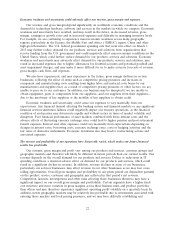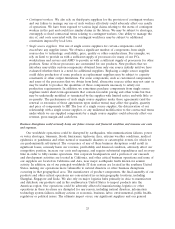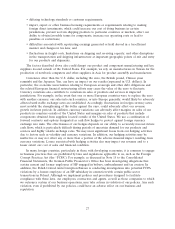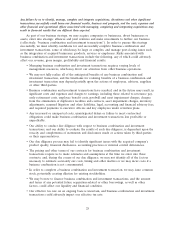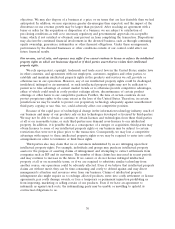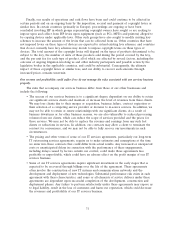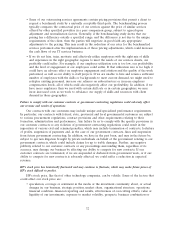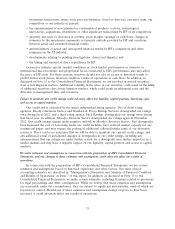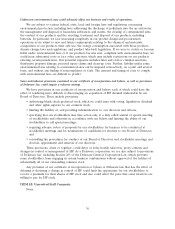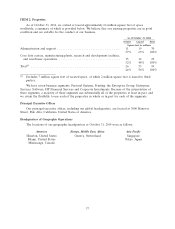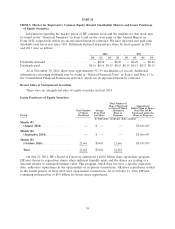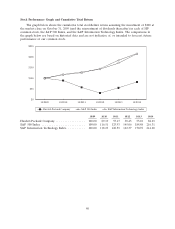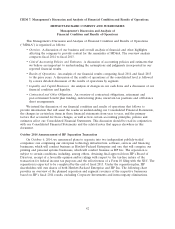HP 2014 Annual Report Download - page 40
Download and view the complete annual report
Please find page 40 of the 2014 HP annual report below. You can navigate through the pages in the report by either clicking on the pages listed below, or by using the keyword search tool below to find specific information within the annual report.• Some of our outsourcing services agreements contain pricing provisions that permit a client to
request a benchmark study by a mutually acceptable third-party. The benchmarking process
typically compares the contractual price of our services against the price of similar services
offered by other specified providers in a peer comparison group, subject to agreed upon
adjustment and normalization factors. Generally, if the benchmarking study shows that our
pricing has a difference outside a specified range, and the difference is not due to the unique
requirements of the client, then the parties will negotiate in good faith any appropriate
adjustments to the pricing. This may result in the reduction of our rates for the benchmarked
services performed after the implementation of those pricing adjustments, which could decrease
the cash flows of our IT services business.
• If we do not hire, train, motivate and effectively utilize employees with the right mix of skills
and experience in the right geographic regions to meet the needs of our services clients, our
profitably could suffer. For example, if our employee utilization rate is too low, our profitability
and the level of engagement of our employees could suffer. If that utilization rate is too high, it
could have an adverse effect on employee engagement and attrition and the quality of the work
performed, as well as our ability to staff projects. If we are unable to hire and retain a sufficient
number of employees with the skills or backgrounds to meet current demand, we might need to
redeploy existing personnel, increase our reliance on subcontractors or increase employee
compensation levels, all of which could also negatively affect our profitability. In addition, if we
have more employees than we need with certain skill sets or in certain geographies, we may
incur increased costs as we work to rebalance our supply of skills and resources with client
demand in those geographies.
Failure to comply with our customer contracts or government contracting regulations could adversely affect
our revenue and results of operations.
Our contracts with our customers may include unique and specialized performance requirements.
In particular, our contracts with federal, state, provincial and local governmental customers are subject
to various procurement regulations, contract provisions and other requirements relating to their
formation, administration and performance. Any failure by us to comply with the specific provisions in
our customer contracts or any violation of government contracting regulations could result in the
imposition of various civil and criminal penalties, which may include termination of contracts, forfeiture
of profits, suspension of payments and, in the case of our government contracts, fines and suspension
from future government contracting. In addition, we have in the past been, and may in the future be,
subject to qui tam litigation brought by private individuals on behalf of the government relating to our
government contracts, which could include claims for up to treble damages. Further, any negative
publicity related to our customer contracts or any proceedings surrounding them, regardless of its
accuracy, may damage our business by affecting our ability to compete for new contracts. If our
customer contracts are terminated, if we are suspended or disbarred from government work, or if our
ability to compete for new contracts is adversely affected, we could suffer a reduction in expected
revenue.
HP’s stock price has historically fluctuated and may continue to fluctuate, which may make future prices of
HP’s stock difficult to predict.
HP’s stock price, like that of other technology companies, can be volatile. Some of the factors that
could affect our stock price are:
• speculation, coverage or sentiment in the media or the investment community about, or actual
changes in, our business, strategic position, market share, organizational structure, operations,
financial condition, financial reporting and results, effectiveness of cost-cutting efforts, value or
liquidity of our investments, exposure to market volatility, prospects, business combination or
32


